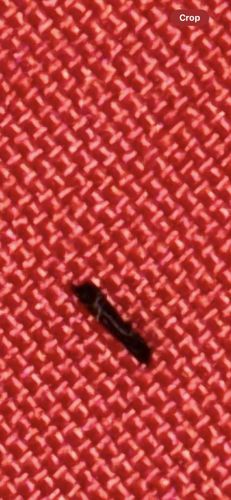Clothing Moth Larva (possibly Black Carpet Beetle Larva based on morphology)
Scientific Name: Tineola bisselliella (for Clothing Moth); Attagenus unicolor (for Black Carpet Beetle)
Order & Family: Lepidoptera (Tineidae for Clothing Moth); Coleoptera (Dermestidae for Carpet Beetle)
Size: Typically 10-15 mm (0.4-0.6 inches) long when fully grown; the one pictured appears to be smaller, likely in an early larval stage.

Natural Habitat
Indoors, particularly in dark, undisturbed areas where animal fibers (wool, silk, fur, feathers) are stored, such as closets, attics, and storage containers. Can also be found feeding on discarded hair, lint, and pet dander.
Diet & Feeding
Keratin-containing materials, primarily natural fibers of animal origin like wool, cashmere, silk, fur, felt, and feathers. They can also feed on lint, dust, hair, and sometimes synthetic blends if animal fibers are present.
Behavior Patterns
Larvae are the destructive stage, voraciously feeding on fibers. They prefer dark, undisturbed locations and will burrow into fabrics, often causing irregular holes; they may also spin silk tunnels or cases. Adults are typically short-lived and do not feed, focusing on reproduction.
Risks & Benefits
Potential risks include significant damage to clothing, carpets, upholstered furniture, and other textiles, leading to economic losses. They pose no direct health risk to humans (do not bite or sting). No significant benefits in a domestic setting; in nature, dermestid larvae can be detritivores, breaking down organic matter.
Identified on: 9/11/2025